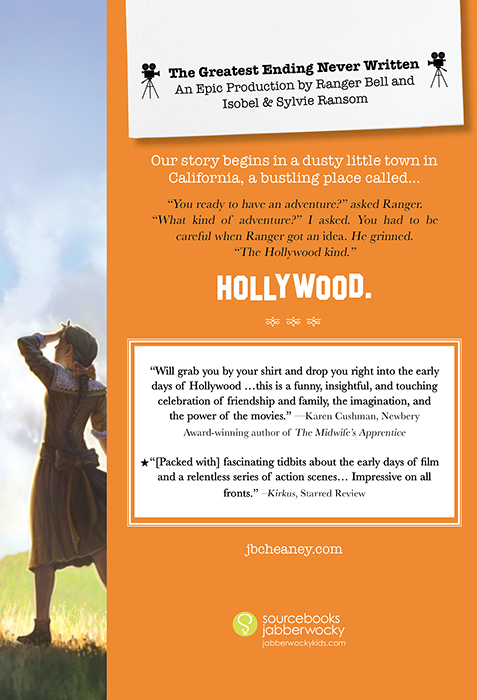I Don't Know How the Story Ends (21 page)
Read I Don't Know How the Story Ends Online
Authors: J.B. Cheaney
What inspired me to start thinking about movie-making in early Hollywood was a statue outside the entrance gate of Universal Studios. It represents a sound stage around the mid-1930s, with two actors, a cameraman, a director, and a sound tech holding a microphone on a crane. From such humble beginnings,
King Kong
and
Star Wars
,
Casablanca
and
The Avengers
. Might there be a story here?
But sooner or later, when constructing a plot, you come up against the cold hard factsâor rather, lack of cold hard facts. A bunch of kids making a movie would need some technical know-how and equipmentâchiefly, a camera. And more specifically, a camera that two teenage boys of not-especially-prepossessing size could haul all over Los Angeles County without attracting much notice. Books couldn't give me that information; I needed to talk to somebody. So I contacted Shannon Perich, a curator in the Division of Culture and the Arts at the Smithsonian's National Museum of American History.
The Smithsonian is called “the nation's attic,” and if the nation is looking for a particular object in connection with a particular project, it is welcome to come in and rummage around. Ms. Perich connected me with John Hiller, then retired, whose long career had included studio work in the film industry as well as cataloging for the Smithsonian. On a lovely day in July, I met Shannon Perich and Mr. Hiller at the entrance to the American History Museum in DC and we drove together out to one of the many Smithsonian storage facilities in Maryland. There I found the Prestwich Model 14 in its cherry-wood case, light and compact enough to carry to the battlefield. Just talking to John was worth a trip: he was a wellspring of little-known facts and telling details like double-splicing film to make for smoother transitions. Thank you both for such extraordinary helpfulness.
Thanks to Vicki Grove, whose husband's grandfather kept a diary during his service as a World War I field surgeon, copies of which she shared with me. Thanks to Aubrey Poole for relentlessly carving out unnecessary material in my manuscript (which seemed so necessary at the time!), for holding firm on the title, and for responding to my own suggestions about the cover. Thanks to the outstanding production team at Sourcebooks for making this book as handsome as Douglas Fairbanks. Thanks to Charlie Chaplin and Buster Keaton for making me laugh, Bobby Harron and Mae Marsh (of The Mother and the Law) for making me cry. Thanks to D. W. Griffith, Mack Sennett, King Vidor, Cecil B. DeMille and many, many others for stretching the limits of storytelling by film. And thanks to the Lord, who plants deep within us a love of stories.
J. B. Cheaney was born in Dallas, Texas, sometime in the last century. In school, her favorite subject was making up parts for herself in imaginary movies and plays. Too bad they don't give grades for that. Fortunately, her second-favorite subject was history. All that daydreaming and history-loving finally paid off with five published novels, the latest of which is
Somebody on This Bus Is Going to Be Famous
. She lives and daydreams in Missouri with her husband.
Thank you for reading
!
At Sourcebooks we are always working on something new and exciting, and we don't want you to miss out.
So sign up now to receive exclusive offers, bonus content, and always be the first to get the scoop on what's new!
